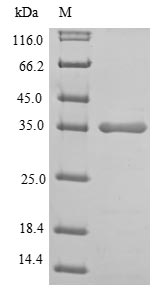This recombinant Human LDHA protein is an E.coli expressed partial protein with Tag-Free and its purity is 85%+ determined by SDS-PAGE. With the appropriate cDNA and PCR methods, LDHA expression plasmids can be rapidly produced. which must undergo denaturation and folding cycle, can be recovered with more modest yields. Hence, using small-scale fermentations and laboratory-scale processing equipment, LDHA proteins (or subdomains thereof) can usually be produced in sufficient quantities to initiate most studies including detailed structural determinations.which must undergo denaturation and folding cycle, can be recovered with more modest yields. Hence, using small-scale fermentations and laboratory-scale processing equipment, LDHA proteins (or subdomains thereof) can usually be produced in sufficient quantities to initiate most studies including detailed structural determinations.
LDHA is a critical glycolytic enzyme that promotes aerobic glycolysis in the cells by catalyzing the interconversion of pyruvate and lactate. It contributes to the increase in glucose uptake and lactate generation in tumor cells and is important for cancer invasion and immune infiltration. High expression of LDHA has been found in a variety of malignancies such as breast cancer, liver cancer, and oral squamous cell carcinoma and has been linked to tumor volume, stage, and degree of cell differentiation as well as affected disease-free survival (DFS) and overall survival (OS). LDHA has recently been associated with lactic acid-related tumor immune infiltration and immune escape.






